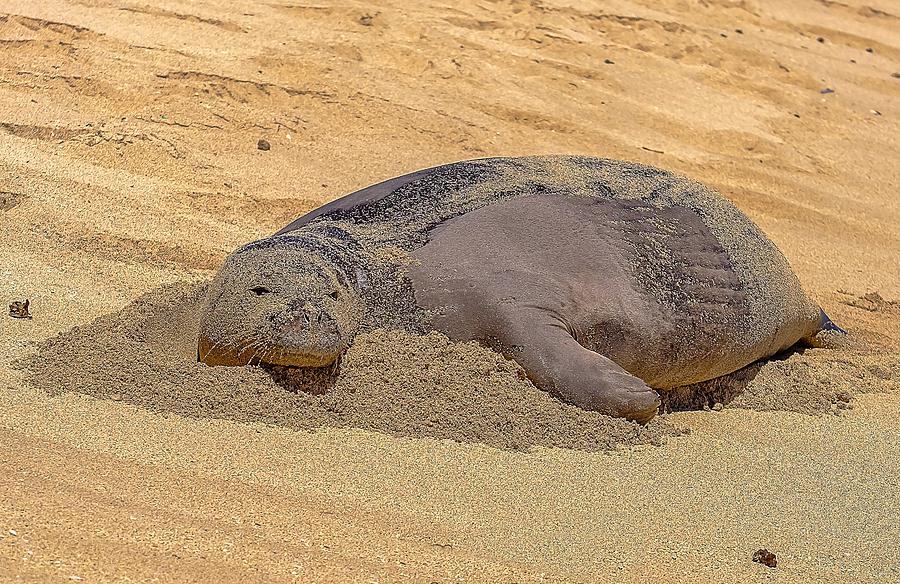Sand seal
Basic Information
Anatomy
Adult sand seals are characterized by prominent tusks and whiskers, and their considerable bulk: adult males can weigh more than 2,000 kg (4,400 lbs.) They are often mistaken for walruses, however, unlike walruses, sand seals have tusks that curve to the sides of their mouths, similar to wild boar. Much of their body mass is comprised of fats designed to absorb as much moisture as possible from the arid environment.
Genetics and Reproduction
Sand seals live to about 20–30 years old in the wild. The males reach sexual maturity as early as two years, but do not typically mate until fully developed at around five years of age. Males compete for access to a harem of females during mating season through violent brawls both above ground and and in the quicksand. Gestation lasts 15 to 16 months. The first three to four months are spent with the blastula in suspended development before it implants itself in the uterus. This strategy of delayed implantation, common among pinnipeds, presumably evolved to optimize both the mating season and the birthing season, determined by ecological conditions that promote newborn survival.
Ecology and Habitats
In the wild, sand seals are found exclusively in the Marrow Desert's vast network of quicksand lakes. They use their ability to "swim" through the dangerous quicksand to access root vegetables, fruits, and cacti that other animals cannot take advantage of. However, they are slow outside of quicksand or sand shores and only come out of the quicksand at night when the air is cool. If the air is too cold, they huddle together for warmth, but usually, they spend the days deep in the quicksand rooting about for food. Sand seals also frequently congregate near underground springs and oases. As a result, the indigenous Marrowmen of the desert use sand seals as guides to hidden wells and reservoirs.
Dietary Needs and Habits
Sand seals forage for root vegetables; starchy, hardy plants; fruits; and cacti. Male sand seals are expected to protect a territory that can sustain his harem as well as find new sources of food. Sand seals can eat up to 200 lbs of food and water in a single day but they can also go for over a week without either.
Additional Information
Social Structure
Sand seals live in small harems numbering 2-6 females and a single male. Occasionally, larger groups of seals will congregate around particularly well-watered or food rich areas. These groups, called drifts or colonies, are often fraught with competition between males. These drifts also kick up a great deal of seismic commotion which attracts some of the sand seal's biggest predators—bulettes. Female sand seals raise pups communally within the harem, though if a male is ousted and loses his harem, the new male will kill the harem's pups.
Domestication
Domesticated sand seals come in two varieties: draft seals and race seals. Draft seals have less fat than their wild counterparts, smaller tusks, and thinner coats. Race seals have even less fat, leaner muscles, and are usually smaller than their wild or draft cousins. Their tusks are also often filed and artificially shaped to make them more responsive to commands.
Uses, Products & Exploitation
Sand seals are used by earth genasi and merchants to as mounts to traverse the dangerous quicksand lakes that comprise the shifting sands of the Marrow Desert. While most Marrowmen do not use sand seals as mounts, they do use them as guides to springs and reservoirs, as well as for their hides and meat. Centuries ago, the genasi also developed a sport, called sandchasing, which involves the racing of sand seals in dangerous competitions on quicksand tracks. The sport grew in popularity during the Palladian Era and was exported throughout the Palladian Empire. Today, sandchasing has dropped in popularity around most of its former range, but remains the national pass-time of its successor state, the Imperium of Iskendra
Geographic Origin and Distribution
Non-contiguous range throughout the Marrow Desert and the Ghostdunes.
Average Intelligence
Low-mid bestial intelligence. Non-sentient.
Perception and Sensory Capabilities
Sand seals find their food and avoid predators by sensing movement through whisker-like hairs integrated into their thin coats. They have relatively poor eyesight, a reasonable sense of smell, and excellent hearing. They communicate both through underground movements such as flapping their flippers or twisting their bodies, as well as through vocalizations when above ground.
Origin/Ancestry
Nioan
Lifespan
20-30 years
Average Weight
Most sand seals weigh between 800 and 1,700 kg (1,800 and 3,700 lb).
Average Length
Length typically ranges from 2.2 to 3.6 m (7.2 to 11.8 ft).


Comments